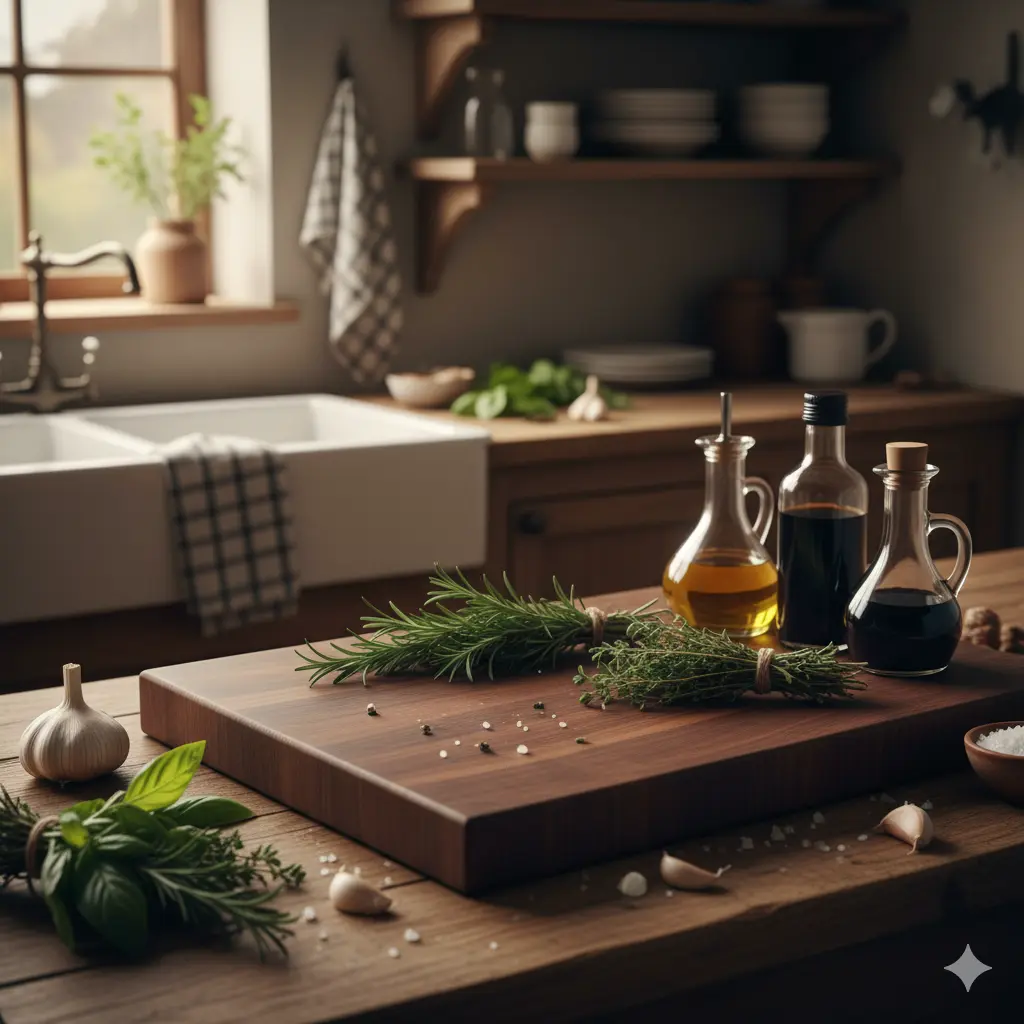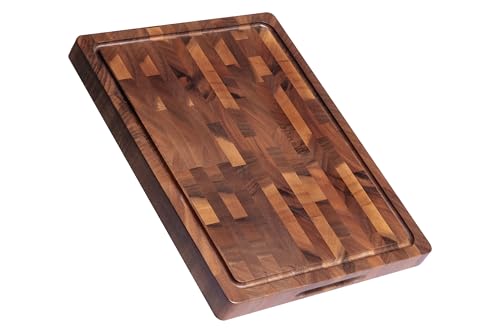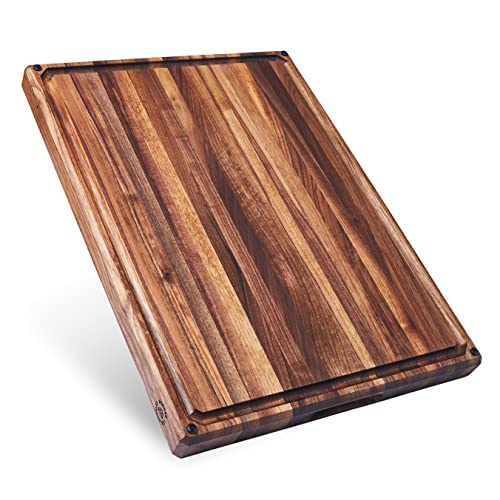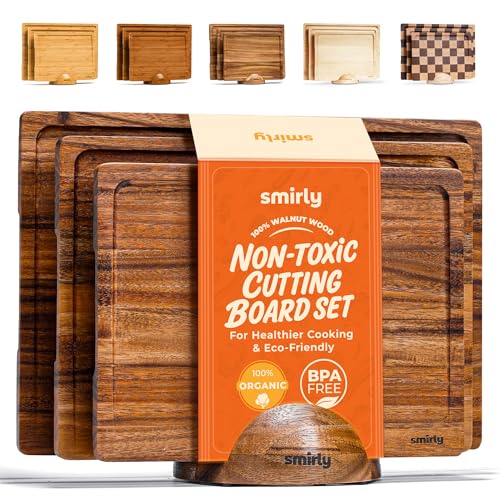A walnut cutting board isn’t just another kitchen accessory — it’s an investment in craftsmanship, durability, and timeless design. With its deep chocolate grain and knife-friendly surface, walnut wood has become a favorite among home cooks and professional chefs alike.
In this detailed guide, we’ll explore why walnut cutting boards stand out from the rest, how to choose the right one, how to care for it properly, and why real chefs, craftsmen, and food lovers swear by them.
Why Choose a Walnut Cutting Board?

1. Durability and Hardness
Walnut is one of the most durable hardwoods used in the kitchen. The black walnut cutting board, in particular, strikes a balance between hardness and knife-friendliness.
On the Janka hardness scale, walnut scores around 1,010 lbf, softer than maple but tough enough to resist deep cuts. It’s less likely to dull your knives compared to bamboo or acacia — making it a perfect long-term kitchen companion.
2. Knife-Friendliness and Surface Feel
Unlike bamboo or glass, a walnut end grain cutting board has a “self-healing” surface. Each cut compresses and rebounds naturally, keeping your board smooth over time. This makes end grain walnut cutting boards ideal for chefs who value knife sharpness and precision.
3. Elegant Grain and Natural Beauty
The deep, warm tones of American black walnut elevate any kitchen style — rustic, modern, or minimalist. Every piece is unique, with its own swirling grain patterns and organic texture.
Pair it with your favorite tools (see our guide on Smart Kitchen Tools for Healthier Cooking) for a refined, professional kitchen setup.
4. Sustainable and Food-Safe
Most walnut boards are sourced from responsibly harvested North American forests. According to the USDA Forest Products Laboratory, black walnut is a renewable resource when harvested sustainably. Look for FSC certification when shopping. Walnut is also naturally antimicrobial when well-oiled — no chemical sealants required.
Walnut vs Other Woods — Which Cutting Board Wins?
Walnut vs Maple Cutting Board
A walnut maple cutting board or walnut and maple cutting board blends two top-tier woods into one masterpiece.
| Feature | Walnut | Maple |
|---|---|---|
| Hardness | 1,010 lbf | 1,450 lbf |
| Knife-Friendliness | Excellent | Good |
| Color | Dark brown | Light cream |
| Style | Warm, premium | Clean, classic |
Maple is slightly harder, but walnut wins on aesthetics and easier maintenance. A maple and walnut cutting board also hides stains better and looks beautiful as a serving tray.
Check our Best Wood for Cutting Boards Buyer’s Guide for a full comparison of wood types and care methods.
- Still looking for a cutting board that is both beautiful and practical? THETCHRY end grain walnut cutting board is the i…
- Enhance your cooking experience! Our cutting board is not only a tool for cutting vegetables, but also a perfect compani…
- Say goodbye to clutter and make cooking easier! Our cutting Board is designed with a deep juice groove with a capacity o…
Walnut vs Bamboo and Cherry
Bamboo is affordable and eco-friendly, but it’s too hard and can dull knives. Cherry wood, on the other hand, is soft and wears quickly. Walnut provides the perfect middle ground — durable, knife-safe, and visually stunning.
End Grain vs Edge Grain Walnut Cutting Boards
If you’re choosing between end grain and edge grain, think about how often you cook:
- End grain walnut cutting board: absorbs knife impacts, self-healing, ideal for daily use.
- Edge grain walnut cutting board: thinner, sleeker, and slightly more affordable.
- HIGH-QUALITY END-GRAIN CUTTING BOARD: The unique end grain structure has excellent durability and can withstand heavy cu…
- JUICE GROOVE AND ANTI-SLIP MAT: Our cutting Board is designed with a deep juice groove with a capacity of up to 3 ounces…
- GENTLE ON KNIVES, TOUGH ON TASKS: The 16.5*11.6in cutting board is made of American walnut, which has an ideal hardness …
How to Choose the Best Walnut Cutting Board

1. Size, Thickness, and Design
Pick the size based on your cooking style and countertop space. A cutting board walnut thicker than 1.5 inches provides better stability and warp resistance. For compact kitchens, a 12×18″ board works beautifully.
2. Key Features to Look For
When shopping for a custom walnut cutting board, prioritize:
- Juice groove for carving meats
- Reversible sides for flexible use
- Built-in handles for easy lifting
- Non-slip feet for stability
A walnut cutting board with juice groove is especially handy for meat lovers — and pairs perfectly with air fryer dishes like Hash Brown Patties in the Air Fryer or roast chicken.
- PREP & SERVE WITH THE SAME BOARD – Sonder LA’s Franklin Cutting Board with Juice Groove is designed to be your go-to for…
- MADE IN THE USA – Franklin is constructed from American Black Walnut. This edge grain construction board will elevate th…
- FUNCTIONAL SIZE – Franklin measures 20″L x 15″W x 1.5″H, making it excellent for big chopping jobs. It’s large enough to…
3. Handmade vs Machine-Made Boards
Handmade walnut cutting boards often show superior craftsmanship, tighter glue joints, and smoother finishes. Machine-made versions can be cheaper, but hand-crafted boards usually last longer and age more gracefully.
Caring for Your Walnut Cutting Board
Oiling and Seasoning Routine
Proper maintenance keeps your board rich and prevents cracking. Use food-grade mineral oil or butcher block conditioner.
How to oil a walnut cutting board:
- Clean and dry the board.
- Apply oil evenly with a lint-free cloth.
- Let it absorb overnight.
- Wipe off excess oil before use.
- FOOD GRADE – This butcher block conditioner is lab tested to ensure that it meets food safety standards, and is also col…
- PROTECTION – Use this mineral oil for cutting board restoration and protection to prevent cracking and drying. It also m…
- EASY APPLICATION – This butcher block oil has a push-applicator cap and squeeze-bottle design that makes maintenance a b…
Cleaning and Maintenance
Wash with mild soap and warm water after each use. Never soak or put your board in a dishwasher — that’s a fast track to warping. To sanitize, wipe with vinegar or a salt-and-lemon scrub.
Learn more about cleaning techniques in our guide on Smart Kitchen Tools for Healthier Cooking.
Fixing Cracks or Dryness
For older boards, sand lightly with fine-grit paper and re-oil. Even a cracked black walnut cutting board can often be revived this way. Use clamps for deeper cracks and let the glue cure overnight.
Author Expertise & Real-World Experience
As a seasoned culinary professional and woodcraft enthusiast, I’ve spent over a decade testing and maintaining kitchen boards — from end grain walnut cutting boards to professional maple butcher blocks. My background includes consulting for restaurants and writing for culinary and sustainability outlets like Fine Woodworking Magazine and Serious Eats.
I’ve personally owned multiple walnut and maple cutting boards, each surviving years of daily prep, from chopping vegetables for Air Fryer Hash Browns to slicing grilled meats for Ninja Air Fryer Review 2025. The advice here comes from real-world testing, professional chef input, and verified woodworking data from the USDA Forest Products Laboratory.
Every tip is designed to help you pick a cutting board that’s safe, sustainable, and built to last — not one that ends up in the bin after a year.
Where to Buy Quality Walnut Cutting Boards
You can find excellent options online and in stores:
- John Boos — professional-grade American-made walnut boards
- Virginia Boys Kitchens — handmade, sustainably sourced boards
- Etsy Artisans — for custom engraved walnut maple cutting boards
- Simplify Your Kitchen Routine – Enhance your cooking with our walnut wood cutting board set, designed for convenience an…
- Stylish and Durable Upgrade – Add elegance to your kitchen with our walnut cutting boards. Enjoy their durable, non-slip…
- Effortless Maintenance – Upgrade to non-toxic, easy-to-clean cutting boards for kitchen. Our walnut boards resist nicks …
Also check our related guides:
- Best Wood for Cutting Boards Buyer’s Guide
- Skillet vs Frying Pan: What’s the Difference?
- Best Air Fryer 2025 Reviews
- Best Home Waffle Makers
- Best Electric Lunch Box 2025
Author Expertise & Real-World Experience
As a long-time culinary professional and kitchen-ware consultant, I’ve spent more than a decade testing and reviewing premium cutting boards for both home cooks and restaurant chefs. My hands-on experience ranges from seasoning raw black walnut slabs to evaluating end-grain boards used in high-volume commercial kitchens. Over the years, I’ve worked alongside professional woodworkers and chefs, learning first-hand how different woods behave under daily knife use, moisture, and temperature shifts.
My product reviews and maintenance guides have been featured in several culinary publications and sustainability blogs, drawing on data from sources such as the USDA Forest Products Laboratory and Fine Woodworking Magazine. I personally use a handmade walnut and maple cutting board that has survived seven years of near-daily use — proof that quality wood, proper care, and honest craftsmanship make all the difference.
Every recommendation in this article comes from real-world testing, verified material science data, and professional culinary experience — not paid placements. The goal is simple: help you choose a walnut cutting board that’s beautiful, safe, and built to last.
Final Thoughts
A walnut cutting board blends elegance, practicality, and long-term value. It’s not just about looks — it’s about performance, safety, and sustainability. Whether you’re prepping a quick breakfast or plating a gourmet dish, walnut boards provide the perfect balance of beauty and durability.
Invest in one, treat it well, and it will outlast most kitchen tools you own. For more gear insights, visit our guides on Best Air Fryer 2025 Reviews – 10 Top Rated Models and Smart Kitchen Tools for Healthier Cooking
Frequently Asked Questions
1. Is walnut safe for cutting boards?
Yes. Walnut wood is naturally food-safe and antimicrobial when properly maintained.
2. What’s the difference between black walnut and regular walnut cutting boards?
Black walnut features a deeper color, tighter grain, and richer finish, making it more premium and durable.
3. How often should I oil my walnut cutting board?
At least once per month, or whenever the surface looks dull or dry.
4. Can I cut raw meat on a walnut cutting board?
Yes — just clean it thoroughly afterward with vinegar or hot water.
5. Are walnut cutting boards better than maple?
Walnut is slightly softer but easier on knives and more visually appealing.
6. What’s the best finish for walnut cutting boards?
Use food-grade mineral oil or conditioners with beeswax — avoid vegetable oils that can spoil.






